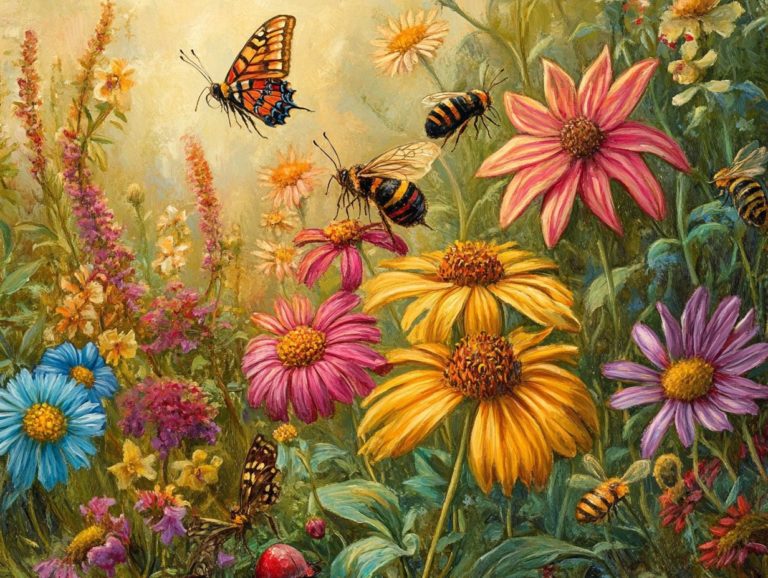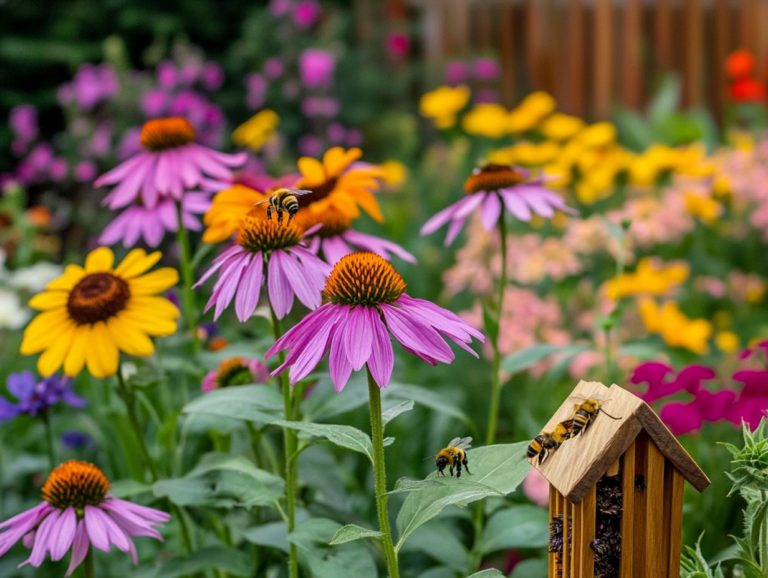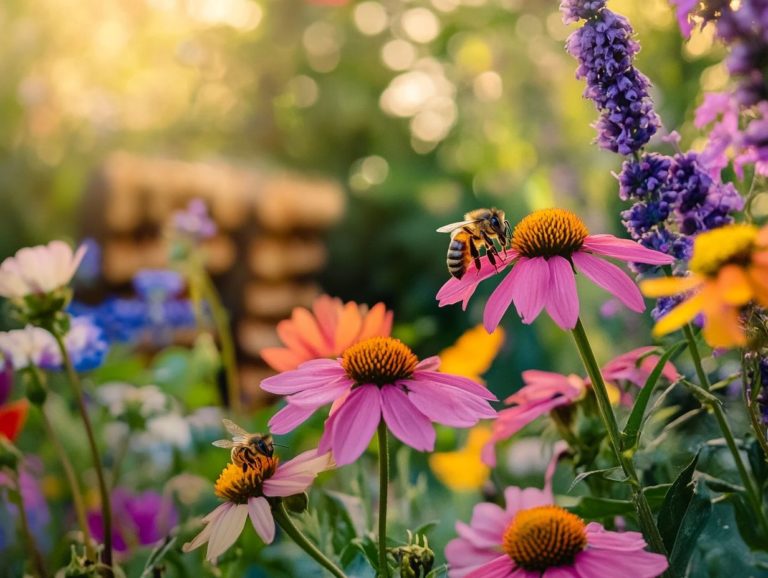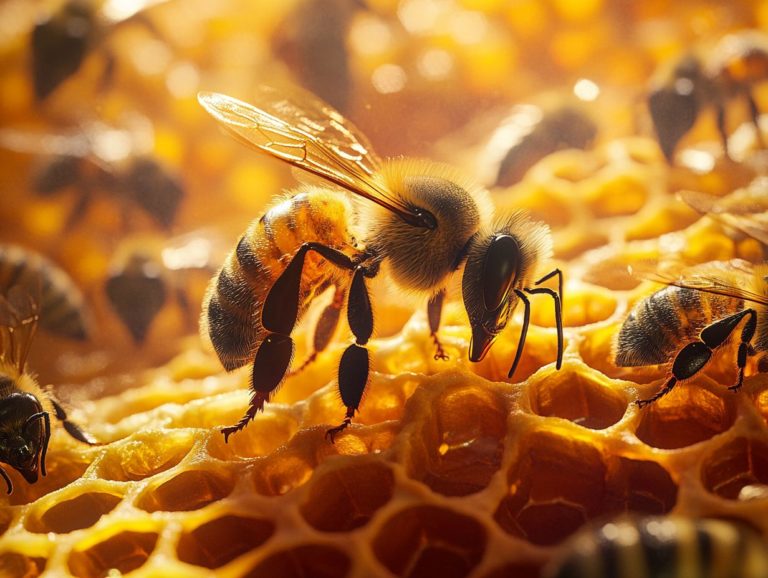Top 5 Most Common Bee Species
Bees, including the European honey bee (Apis mellifera) and the Asian honey bee (Apis cerana), are indispensable contributors to our ecosystems, functioning as crucial pollinators for a diverse array of plants and crops.
You will also learn about different bee families such as Melittidae, Halictidae, Megachilidae, Colletidae, Stenotritidae, and Andrenidae.
Furthermore, you will explore the myriad benefits that bees provide to humanity, the challenges they encounter, and the ways you can actively contribute to their conservation, which includes learning how to attract different types of bees to support the health of bees in your area.
Dive into the fascinating world of bees and discover their amazing secrets!
Contents
- Exciting Insights About Bees!
- 1. Honey Bees
- 2. Bumble Bees
- 3. Carpenter Bees
- 4. Mason Bees
- 5. Sweat Bees
- What Are the Characteristics of Each Bee Species?
- Frequently Asked Questions
- What are the top 5 most common bee species?
- What makes honey bees one of the top 5 most common bee species?
- Are bumblebees considered one of the top 5 most common bee species?
- Why are carpenter bees one of the top 5 most common bee species?
- What sets sweat bees apart as one of the top 5 most common bee species?
- Why are mason bees included in the top 5 most common bee species?
Exciting Insights About Bees!

- Honey bees, including the European honey bee (Apis mellifera) and the Asian honey bee (Apis cerana), are the most well-known bee species, important for pollination and honey production.
- Bumble bees have fuzzy bodies and are important pollinators for both wildflowers and crops.
- Carpenter bees are solitary nesters and play a key role in pollination.
1. Honey Bees
Honey bees, particularly the European honey bee (Apis mellifera) and the Asian honey bee (Apis cerana), are important contributors to our ecosystems, thanks to their remarkable pollination skills. They don t just help plants grow; they improve the overall health of different ecosystems.
You can easily spot these fascinating insects by their distinct traits and behaviors, from their intricate social structures to their unwavering commitment to producing honey a substance that serves as both nourishment and a crucial resource for many organisms, including humans, who rely on their pollination services. Notably, experts like Noah Wilson-Rich from The Best Bees Company have shed light on the importance of these species.
Within a honey bee colony, you’ll find a sophisticated social structure where different types of bees have specific roles, including a queen, worker bees, and drones. Their life cycle unfolds through a series of stages: egg, larva, pupa, and finally adulthood, all supported by the diligent efforts of the worker bees.
Unlike solitary bees, honey bees thrive in large colonies that can number in the thousands, amplifying their effectiveness as pollinators. This contrast in social structure highlights the difference between bees and wasps, which often live solitary lives or in smaller colonies.
They have a penchant for unique nesting habits, often opting for sheltered spots like tree hollows or manmade hives to establish their homes.
Their extraordinary skill in pollinating a wide range of crops makes them essential to agriculture. In fact, about one-third of the food you consume globally depends on their pollination activities, which in turn supports biodiversity and food security. The “State of the Honey Bee Report” often highlights these significant contributions.
2. Bumble Bees
Bumble bees, part of the genus Bombus, are striking and robust pollinators that stand apart with their fuzzy bodies and loud buzzing. This is a stark contrast to the more familiar honey bees. These intriguing insects, including species like the common bumble bee, play a crucial role in the pollination of numerous flowering plants and crops.
Their remarkable foraging behavior enables them to thrive in a variety of environments, making them essential players in both ecosystems and agriculture. With over 250 species scattered across the globe, bumble bees, such as Bombus hortorum and Bombus impatiens, showcase a range of nesting habits. They often choose to create homes in underground burrows or repurpose abandoned rodent nests.
Unlike honey bees, which thrive in large, organized colonies, bumble bee colonies tend to be smaller, typically consisting of a queen and a handful of workers. This structural difference exemplifies their adaptability and diverse lifestyles.
Recognizing bumble bees is a delightful experience; just look for their size, distinctive color patterns, and the vibrant fluffiness of their fur as they flit from flower to flower. Their role in pollination is nothing short of vital. They efficiently transfer pollen during their foraging expeditions, enhancing plant reproduction and boosting biodiversity.
Learning about these amazing bees shows just how important they are to our environment!
3. Carpenter Bees
Carpenter bees stand out in the bee family for their unique nesting habits. Unlike other bees, they burrow into wood to create their homes, showcasing an interesting habit that makes them different. These sturdy insects may resemble bumblebees, but they typically lack the fuzzy appearance that many associate with their cousins.
Not only are they significant pollinators, but you will also notice their shiny, hairless abdomens and assertive territorial behavior, especially during the mating season.
The nesting process is quite intriguing. A female carpenter bee begins by excavating a tunnel in dead wood, where she lovingly lays her eggs in small chambers. She seals each one with a delightful mixture of pollen and nectar.
As they progress through their lifecycle, which includes egg, larval, and pupal stages, they help the environment by aiding in the pollination of various plants including your favorite fruits and vegetables.
Though some may mistakenly label them as destructive pests, carpenter bees play a vital role in maintaining biodiversity. Their presence also helps increase biodiversity by supporting hundreds of other species that depend on flowers for survival.
4. Mason Bees

Mason bees are a fascinating type of solitary bee, which means a bee that lives alone instead of in a colony, that play a crucial role in pollination. You might find their unique nesting behavior particularly captivating, as they utilize natural cavities and burrows to lay their eggs. Unlike honey bees and bumblebees, which thrive in colonies, mason bees prefer to go solo, fulfilling essential ecological roles by pollinating a wide variety of plants.
These industrious bees have a penchant for nesting in tiny tunnels found in dead wood, hollow stems, or even in man-made bee houses. Here, they create individual cells for each egg, showcasing their meticulous nature. You can easily distinguish them from other bee species by their fuzzy, robust bodies and their striking blue or green metallic sheen.
As efficient pollinators, mason bees exhibit a targeted approach to visiting flowers, resulting in higher rates of pollen transfer to various crops significantly enhancing agricultural yields. Their presence also contributes to greater biodiversity, supporting the growth and reproduction of a multitude of plant species.
Without these bees, our gardens and farms could face serious challenges!
5. Sweat Bees
Sweat bees belong to the family Halictidae. They are often overlooked, yet they serve as essential pollinators across various habitats, from your own garden to idyllic wildflower fields. You may recognize them by their curious attraction to human sweat.
These small, solitary insects play a crucial role in the pollination of many flowering plants. They showcase remarkable adaptability and thrive in diverse environments, often remaining unnoticed due to their unassuming appearance.
Within this family, you ll find several species of sweat bees, each displaying unique behaviors and nesting habits that significantly contribute to the ecosystem. These bees have metallic-colored bodies, which can range from vibrant green to deep blue or even black. Keep your eyes peeled! These traits make it easy to spot them as they exhibit rapid, darting flight patterns and a penchant for visiting a wide array of flowers.
Most sweat bees prefer to nest underground, crafting small burrows. Others take to nesting in wood or plant stems. Understanding their nesting preferences provides valuable insight into their survival strategies and emphasizes the importance of preserving their habitats. After all, their vital role in boosting biodiversity and supporting food production is truly essential.
What Are the Characteristics of Each Bee Species?
Understanding the characteristics of each bee species is essential for recognizing their unique roles in pollination and their vital contributions to the ecosystem. Different types of bees honey bees, bumble bees, carpenter bees, mason bees, and sweat bees showcase distinct physical features, behaviors, and nesting habits.
These traits reflect their adaptations to various environmental conditions and their specific roles in supporting the health of plants and agricultural systems.
Take honey bees, for instance. They are renowned for their structured social communities and efficient foraging patterns, allowing them to pollinate a wide range of crops with remarkable effectiveness. On the other hand, bumble bees possess robust bodies and thrive in cooler temperatures, making them critical for pollinating specific flowers that require a way some bees shake flowers to release pollen.
Solitary bees like mason bees and carpenter bees also play unique roles. They often nest in natural cavities, using mud or wood to create their homes, which enables them to pollinate plants that may not attract larger colonies. These behavioral traits not only enhance their survival but also significantly boost biodiversity, ensuring a rich variety of flora flourishes in their environments. Observing bee behavior in these solitary species helps us understand their vital ecological functions better.
Where Can Each Bee Species Be Found?
Each species of bee has adapted to thrive in specific habitats, whether it be your urban garden or a wildflower meadow, significantly influencing their distribution and activities.
The climate is a crucial factor in determining where these bees can flourish. Honey bees, known for their remarkable resilience, thrive in warm agricultural regions where crops are in full bloom. In contrast, bumble bees (Bombus), with their unique ability to generate heat, are perfectly at home in cooler environments like mountainous areas and woodlands.
Solitary bees, such as leafcutter bees, often gravitate toward lush, vibrant locales abundant in specific plant species, using fragments of leaves to build their nests. Many solitary bees, like those in the Megachilidae family, nest in burrows. Their nesting preferences are closely tied to their local surroundings, highlighting how environmental conditions intricately shape their habitats and reproductive strategies.
Have you spotted a sweat bee in your garden? Share your experiences!
What Is the Role of Each Bee Species in the Ecosystem?

Bees are vital in maintaining ecological balance through their essential pollination activities. These activities support the reproduction of flowering plants and enhance the overall health of ecosystems. Each species, from the industrious honey bee (Apis mellifera) that bolsters agriculture to the invaluable bumble bee (Bombus) and solitary bees, plays a unique role in fostering biodiversity. This diversity ensures the survival of numerous plant species and the animals that depend on them.
Consider, for example, the wildflowers like clover and bluebells that rely heavily on bumble bees (Bombus hortorum) for effective pollination. Fruit trees such as apples and cherries depend on honey bees (Apis mellifera) to produce their delicious fruit. Solitary bees, like the mason bee, are crucial for crops such as blueberries and cranberries.
If any bee species declines, we risk major problems in our food supply. The drop in pollination can lead to reduced yields, threatening local ecosystems, as many animals rely on these plants for food and habitat. We must act now to support bee health for our ecosystems’ survival!
How Do These Bee Species Benefit Humans?
The benefits of bees to you are immense and multifaceted, primarily stemming from their exceptional role in pollination. This essential process is crucial for producing many fruits, vegetables, and nuts that grace your table daily. Honey bees, in particular, boost agricultural yields, while bumble bees (Bombus impatiens) enhance both the quality and quantity of crops by pollinating plants that honey bees may overlook.
This intricate dance of pollination underpins a significant portion of the global agricultural economy. Estimates indicate that bee pollination is vital for about one-third of the food produced for human consumption. Farmers rely on these industrious insects to increase crop yields, leading to higher profits and lower food production costs. For example, Apis mellifera and Apis cerana (Asian honey bee) are crucial for pollinating various crops around the world.
The diverse array of crops supported by bee populations satisfies your dietary needs while maintaining ecological balance. Understanding and protecting these crucial pollinators is essential for ensuring sustainable food systems and economic stability. Notable experts like Noah Wilson-Rich from The Best Bees Company underscore the importance of bee conservation in modern agriculture.
What Threats Do These Bee Species Face?
Bee populations are currently facing significant threats due to various factors, including habitat loss, pesticide exposure, and the impacts of climate change. These challenges endanger bee health and survival. Honey bees have seen dramatic declines due to Colony Collapse Disorder, while bumble bees and solitary bees are equally vulnerable to environmental changes and human activities.
Recent studies reveal that over 30% of bumble bee species in North America are experiencing population declines, largely attributed to habitat destruction linked to urbanization and agricultural expansion. Solitary bee populations may have dropped by over 50% in certain areas. The excessive use of neonicotinoids, a type of pesticide that can harm bees, has been closely associated with harmful impacts on bees’ foraging behavior and reproductive success. To learn more about the diverse families of bees impacted by these adverse conditions, explore the 5 most interesting bee species worldwide, including families like Halictidae, Melittidae, Colletidae, Stenotritidae, and Andrenidae.
The State of the Honey Bee Report highlights that nearly one in four colonies failed during the winter of 2020-2021. This underscores the urgency of addressing these multifaceted threats to ensure the stability of bee populations essential for pollination and biodiversity. Addressing issues caused by climate change and pesticide exposure is vital to counteract these declines.
How Can We Help Protect These Bee Species?
Protecting bee species is essential for maintaining healthy ecosystems and ensuring food security. There are numerous ways you and your community can contribute to their conservation efforts.
Start your journey today by creating bee-friendly habitats, reducing pesticide use, and supporting local beekeepers. You can play a pivotal role in safeguarding honey bees, bumble bees, and solitary bees, thus promoting biodiversity and environmental health. Ensuring an ample supply of nectar and pollen is critical for the survival of these pollinators.
Planting native wildflowers and flowering plants that attract bees provides the essential food sources they need. Establishing bee habitats, like bee hotels or wildflower meadows, creates safe spaces for these vital pollinators to nest and forage. Advocating for farming methods that are good for the environment, such as organic farming and crop rotation, can significantly enhance bee health and boost their populations. The importance of bee-friendly practices is critical for the conservation of species in families like Apis and Megachilidae.
Education plays an important role in this effort; consider organizing workshops in your community to raise awareness about the importance of bees and the ways to protect them. Initiatives that connect local schools with pollinator gardens not only educate but also foster a sense of responsibility among the younger generation, ensuring a lasting commitment to bee conservation for years to come. Highlighting the contributions of different bee species, including the European honey bee (Apis mellifera) and Asian honey bee (Apis cerana), can enhance community understanding and support for these key pollinators.
Frequently Asked Questions

What are the top 5 most common bee species?
The top 5 most common bee species are:
- Honey bees
- Bumblebees
- Carpenter bees
- Sweat bees
- Mason bees
What makes honey bees one of the top 5 most common bee species?
Honey bees are one of the top 5 most common bee species because they are the most commercially important pollinators and produce honey.
Are bumblebees considered one of the top 5 most common bee species?
Yes, bumblebees are considered one of the top 5 most common bee species due to their widespread distribution and importance as pollinators for a variety of plants.
Why are carpenter bees one of the top 5 most common bee species?
Carpenter bees are one of the top 5 most common bee species because they are found in most regions of the world and are important pollinators for many plant species.
What sets sweat bees apart as one of the top 5 most common bee species?
Sweat bees are one of the top 5 most common bee species because they are highly adaptable and can be found in a variety of habitats, including urban areas.
Why are mason bees included in the top 5 most common bee species?
Mason bees are one of the top 5 most common bee species because they are excellent pollinators for early blooming crops and are often used in agricultural settings.






